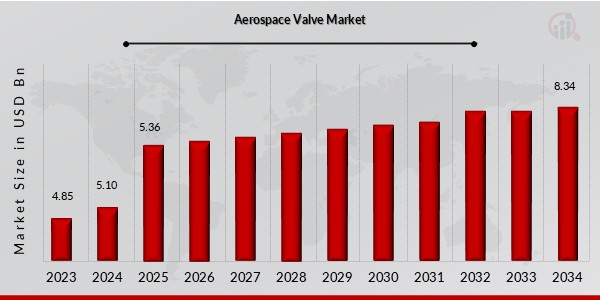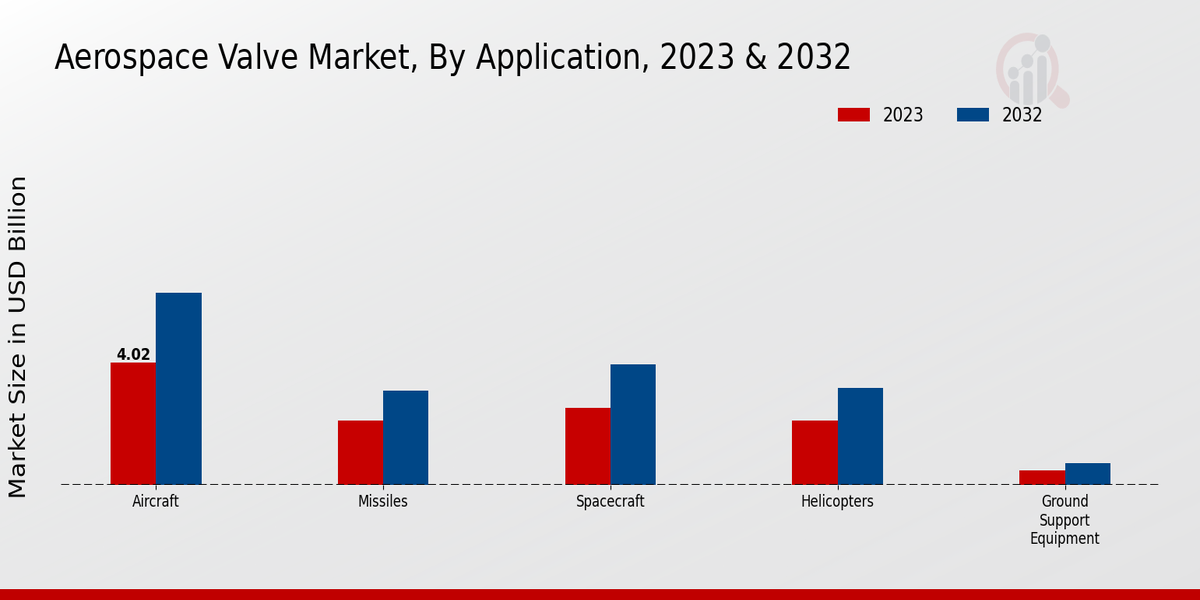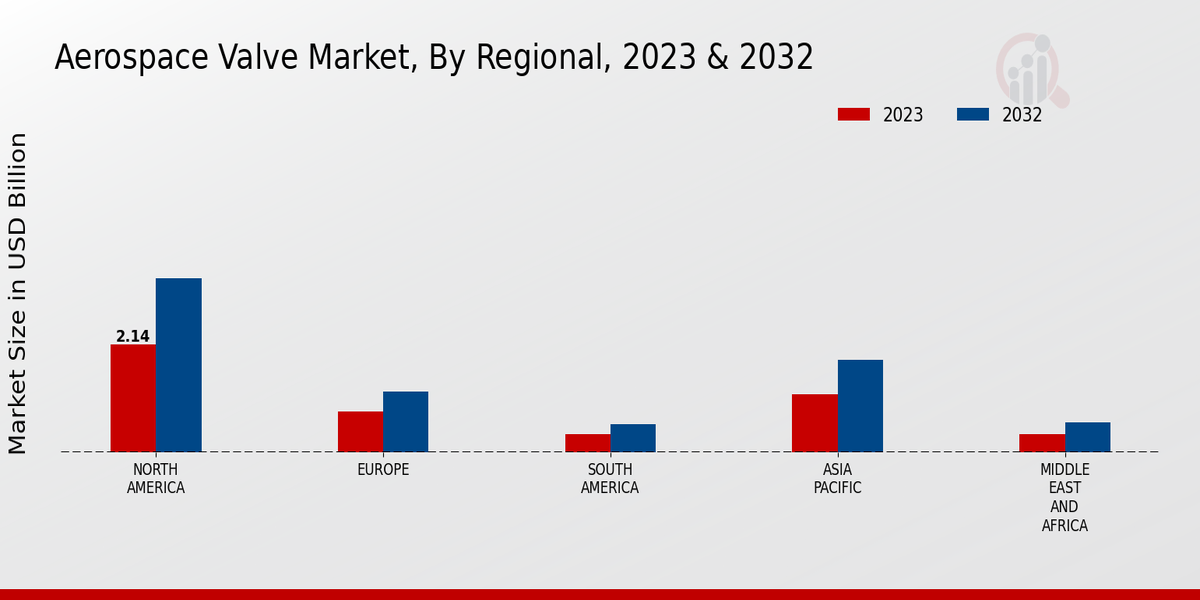Global Aerospace Valve Market Overview
Aerospace Valve Market Size was estimated at 5.10 (USD Billion) in 2024. The Aerospace Valve Market Industry is expected to grow from 5.36 (USD Billion) in 2025 to 8.34 (USD Billion) by 2034. The Aerospace Valve Market CAGR (growth rate) is expected to be around 5.0% during the forecast period (2025 - 2034).
 Source Primary Research, Secondary Research, MRFR Database and Analyst Review
Key Aerospace Valve Market Trends Highlighted
Source Primary Research, Secondary Research, MRFR Database and Analyst Review
Key Aerospace Valve Market Trends Highlighted
The Aerospace Valve Market is experiencing significant growth, primarily driven by rising demand for commercial and military aircraft, technological advancements, and increasing safety regulations. The market is also poised to benefit from the growing popularity of unmanned aerial vehicles (UAVs) and the adoption of autonomous systems in the aerospace industry. Key market trends include the integration of advanced materials, such as composites and lightweight alloys, to enhance valve performance and reduce weight. Additionally, the use of digital technologies, including sensors and data analytics, is facilitating remote monitoring and predictive maintenance of valves, improving efficiency and safety. The market is also witnessing a shift towards sustainable solutions, with manufacturers focusing on developing valves that meet environmental regulations and reduce emissions.
Aerospace Valve Market Drivers
Rising Demand for Advanced Aircraft and Spacecraft
The aerospace industry is experiencing a surge in demand for advanced aircraft and spacecraft. This is due to factors such as the increasing popularity of air travel, the growing need for defense and security, and the exploration of space. As a result, there is a growing demand for aerospace valves that can meet the stringent requirements of these advanced systems. Aerospace valves are critical components in aircraft and spacecraft, as they control the flow of fluids and gases.They must be lightweight, durable, and reliable, and they must be able to withstand extreme temperatures and pressures. The rising demand for advanced aircraft and spacecraft is therefore one of the key drivers of growth in the aerospace valve market.
Increasing Focus on Safety and Efficiency
The aerospace industry is also increasingly focused on safety and efficiency. This is due to the rising number of air accidents and the need to reduce operating costs. As a result, there is a growing demand for aerospace valves that can improve safety and efficiency. Aerospace valves can help to improve safety by preventing leaks and failures, and they can help to improve efficiency by reducing weight and drag. The increasing focus on safety and efficiency is therefore another key driver of growth in the aerospace valve market.
Technological Advancements
The aerospace industry is also experiencing a number of technological advancements. These advancements are leading to the development of new and improved aerospace valves. For example, the use of additive manufacturing is enabling the production of complex aerospace valves with improved performance. The development of new materials is also leading to the development of aerospace valves that are lighter, stronger, and more durable. These technological advancements are expected to drive growth in the aerospace valve market in the coming years.
Aerospace Valve Market Segment Insights
Aerospace Valve Market Application Insights
The Aerospace Valve Market is segmented based on application into Aircraft, Helicopters, Spacecraft, Missiles, and Ground Support Equipment. The Aircraft segment held the largest market share in 2023 and is projected to continue its dominance throughout the forecast period. The growth of the Aircraft segment can be attributed to the increasing demand for commercial aircraft and the rising number of aircraft deliveries. The Helicopters segment is expected to witness a significant growth rate during the forecast period due to the growing demand for helicopters in military and civil applications.The Spacecraft segment is also expected to grow at a steady pace due to the increasing number of space exploration missions and the development of new spacecraft technologies. The Missiles segment is expected to experience moderate growth due to the rising demand for missiles in defense applications. The growth of the market can be attributed to the increasing demand for aerospace valves in various applications, including aircraft, helicopters, spacecraft, missiles, and ground support equipment. The rising number of aircraft deliveries, increasing defense spending, and growing space exploration activities are some of the key factors driving the market growth.Additionally, the technological advancements in aerospace valves, such as the development of lightweight and high-performance valves, are expected to further contribute to the market growth.
 Source Primary Research, Secondary Research, MRFR Database and Analyst Review
Aerospace Valve Market Valve Type Insights
Source Primary Research, Secondary Research, MRFR Database and Analyst Review
Aerospace Valve Market Valve Type Insights
The Aerospace Valve Market is segmented into various types of valves, including control valves, pressure valves, check valves, flow control valves, relief valves, and shutoff valves. Each type of valve serves a specific purpose in aerospace systems and contributes to the overall market growth. Control valves regulate the flow of fluids and gases in aerospace systems. They are essential for controlling pressure, temperature, and flow rates in various applications, such as fuel systems, hydraulic systems, and environmental control systems. The aerospace valve market for control valves is expected to reach USD 1.25 billion by 2024, growing at a CAGR of 4.5%.Pressure valves are designed to maintain or relieve pressure in aerospace systems. They are used in applications where pressure control is critical, such as fuel tanks, hydraulic systems, and propulsion systems. The aerospace valve market for pressure valves is projected to reach USD 950 million by 2024, growing at a CAGR of 3.8%. Check valves allow fluid flow in one direction while preventing flow in the opposite direction. They are used in various aerospace applications, such as fuel systems, hydraulic systems, and lubrication systems.The aerospace valve market for check valves is expected to reach USD 780 million by 2024, growing at a CAGR of 3.2%. Flow control valves are used to regulate the flow rate of fluids and gases in aerospace systems. They are essential for controlling the flow of fluids in various applications, such as fuel systems, hydraulic systems, and cooling systems. The aerospace valve market for flow control valves is projected to reach USD 650 million by 2024, growing at a CAGR of 2.8%. Relief valves are designed to protect aerospace systems from excessive pressure.They open when the pressure exceeds a predetermined level, allowing excess pressure to escape. Relief valves are used in various applications, such as fuel tanks, hydraulic systems, and propulsion systems. The aerospace valve market for relief valves is expected to reach USD 580 million by 2024, growing at a CAGR of 2.5%. Shutoff valves are used to isolate or shut off the flow of fluids and gases in aerospace systems. They are essential for maintenance, repairs, and emergency situations. Shutoff valves are used in various applications, such as fuel systems, hydraulic systems, and lubrication systems.The aerospace valve market for shutoff valves is projected to reach USD 420 million by 2024, growing at a CAGR of 2.0%.
Aerospace Valve Market Material Insights
The Material segment of the Aerospace Valve Market is anticipated to witness significant growth over the forecast period owing to the increasing demand for lightweight and durable materials in aerospace applications. Titanium, with its high strength-to-weight ratio and corrosion resistance, is widely used in the manufacturing of critical valve components, such as bodies, stems, and seats. Steel, known for its strength and affordability, remains a popular choice for valves in less demanding applications. Aluminum, with its lightweight and corrosion-resistant properties, is gaining traction in the aerospace industry for valve applications.Nickel alloys, offering exceptional high-temperature resistance and strength, are used in valves designed for extreme environments. Composite materials, such as carbon fiber reinforced polymers, provide a unique combination of lightweight, high strength, and corrosion resistance, making them suitable for specialized valve applications. The Aerospace Valve Market revenue from Material segment is projected to reach USD 2.3 billion by 2024, exhibiting a steady growth rate over the forecast period.
Aerospace Valve Market Pressure Rating Insights
Pressure Rating Segment Insights and Overview Pressure rating is a critical factor in the design and selection of aerospace valves, as it determines the valve's ability to withstand different levels of fluid pressure. The Aerospace Valve Market is segmented into four pressure rating categories low pressure, medium pressure, high pressure, and ultra-high pressure. Low Pressure Low pressure valves are designed to handle pressures up to 150 psi (pounds per square inch) and are commonly used in applications such as fuel and hydraulic systems.Medium Pressure Medium pressure valves can withstand pressures ranging from 150 to 1,000 psi and are employed in systems requiring higher pressure tolerance, such as engine oil and cooling systems. High Pressure High pressure valves are capable of handling pressures between 1,000 and 6,000 psi and are used in critical applications such as hydraulic flight control systems and landing gear systems. Ultra-High Pressure Ultra-high-pressure valves are specifically designed to withstand pressures exceeding 6,000 psi and are employed in highly demanding applications, including rocket engines and fuel delivery systems.The aerospace valve market revenue for the high-pressure segment is projected to reach USD 2.5 billion by 2024, exhibiting a significant market growth. This growth is primarily driven by the increasing demand for high-performance valves in commercial and military aircraft, as well as the growing adoption of hydraulic systems in aerospace applications.
Aerospace Valve Market Flow Rate Insights
The Aerospace Valve Market is segmented by Flow Rate into Low Flow Rate, Medium Flow Rate, and High Flow Rate. Among these, the Medium Flow Rate segment is estimated to hold the largest market share in 2024, accounting for around 42% of the Aerospace Valve Market revenue. This is primarily due to the increasing demand for medium flow rate valves in various aerospace applications, such as fuel systems, hydraulic systems, and environmental control systems. The High Flow Rate segment is expected to witness significant growth over the forecast period, owing to the rising demand for high flow rate valves in large commercial aircraft and military aircraft.The Low Flow Rate segment is also expected to grow steadily, driven by the increasing use of low flow rate valves in small aircraft and unmanned aerial vehicles (UAVs).
Aerospace Valve Market Regional Insights
The regional segmentation of the Aerospace Valve Market offers valuable insights into the market's growth dynamics and opportunities across different regions. North America is expected to dominate the market with a significant share due to the presence of leading aerospace manufacturers and a strong defense sector. Europe is another key region, driven by advancements in aerospace technology and increasing demand for commercial aircraft. The APAC region is projected to witness substantial growth, fueled by the rising aviation industry and government initiatives to develop domestic aerospace capabilities.South America and MEA are emerging markets with growing demand for aerospace valves, particularly in the commercial aviation and defense sectors. Understanding the regional market dynamics and tailoring strategies accordingly will be crucial for manufacturers to capitalize on growth opportunities and gain a competitive edge.
 Source Primary Research, Secondary Research, MRFR Database and Analyst Review
Aerospace Valve Market Key Players And Competitive Insights
Source Primary Research, Secondary Research, MRFR Database and Analyst Review
Aerospace Valve Market Key Players And Competitive Insights
Major players in the Aerospace Valve Market industry are constantly striving to gain a competitive advantage by investing in research and development. Leading Aerospace Valve Market players are focusing on developing innovative products and technologies to meet the evolving needs of the aerospace industry. The Aerospace Valve Market is expected to witness significant growth in the coming years, driven by factors such as increasing demand for commercial aircraft, rising defense expenditure, and growing emphasis on safety and efficiency in the aerospace industry.Honeywell International is a leading Aerospace Valve Market player with a strong focus on innovation and customer satisfaction. The company offers a wide range of aerospace valves, including ball valves, gate valves, check valves, and solenoid valves. Honeywell has a presence and serves major aerospace manufacturers and airlines. The company is committed to providing high-quality products and services and has received numerous industry awards and certifications.Parker Hannifin is another major competitor in the Aerospace Valve Market. The company has a long history of supplying valves to the aerospace industry and offers a wide range of products for various applications. Parker Hannifin is known for its expertise in fluid power and motion control systems and has a strong presence. The company is focused on providing innovative solutions and excellent customer service and has received numerous awards for its products and services.
Key Companies in the Aerospace Valve Market Include
- Woodward
- CurtissWright Corporation
- Moog Inc.
- Crane Aerospace Electronics
- General Electric Company
- Parker Hannifin Corporation
- Meggitt PLC
- Collins Aerospace
- Safran S.A.
- LiebherrAerospace Lindenberg GmbH
- Triumph Group, Inc.
- Eaton Corporation plc
- Avio Aero
- Safran Landing Systems
- Honeywell International Inc.
Aerospace Valve Market Industry Developments
The aerospace valve market is poised to exhibit steady growth, driven by increasing aircraft production, rising demand for commercial aircraft, and growing investments in defense and space exploration. Technological advancements, such as the adoption of additive manufacturing and the integration of sensors and electronics, are expected to further drive market expansion. Key market players are focusing on strategic partnerships, acquisitions, and product development to strengthen their market positions. Recent news developments include the acquisition of Moog Inc.'s aerospace business by TransDigm Group and the launch of new valve products by Parker Hannifin Corporation. Government initiatives and regulations related to aerospace and defense spending are expected to influence market dynamics.
Aerospace Valve Market Segmentation Insights
- Aerospace Valve Market Application Outlook
- Aircraft
- Helicopters
- Spacecraft
- Missiles
- Ground Support Equipment
- Aerospace Valve Market Valve Type Outlook
- Control Valves
- Pressure Valves
- Check Valves
- Flow Control Valves
- Relief Valves
- Shutoff Valves
- Aerospace Valve Market Material Outlook
- Titanium
- Steel
- Aluminum
- Nickel Alloys
- Composite Materials
- Aerospace Valve Market Pressure Rating Outlook
- Low Pressure
- Medium Pressure
- High Pressure
- Ultra-High Pressure
- Aerospace Valve Market Flow Rate Outlook
- Low Flow Rate
- Medium Flow Rate
- High Flow Rate
- Aerospace Valve Market Regional Outlook
- North America
- Europe
- South America
- Asia Pacific
- Middle East and Africa
Aerospace Valve Market Report Scope
| Report Attribute/Metric |
Details |
| Market Size 2024 |
5.10(USD Billion) |
| Market Size 2025 |
5.36(USD Billion) |
| Market Size 2034 |
8.34(USD Billion) |
| Compound Annual Growth Rate (CAGR) |
5.0% (2025 - 2034) |
| Report Coverage |
Revenue Forecast, Competitive Landscape, Growth Factors, and Trends |
| Base Year |
2024 |
| Market Forecast Period |
2025 - 2034 |
| Historical Data |
2021 - 2024 |
| Market Forecast Units |
USD Billion |
| Key Companies Profiled |
Woodward, CurtissWright Corporation, Moog Inc., Crane Aerospace Electronics, General Electric Company, Parker Hannifin Corporation, Meggitt PLC, Collins Aerospace, Safran S.A., LiebherrAerospace Lindenberg GmbH, Triumph Group, Inc., Eaton Corporation plc, Avio Aero, Safran Landing Systems, Honeywell International Inc. |
| Segments Covered |
Application, Valve Type, Material, Pressure Rating, Flow Rate, Regional |
| Key Market Opportunities |
Rising demand for commercial aircraft Growing focus on safety and reliability Technological advancements Increased MRO activities Expansion of emerging markets |
| Key Market Dynamics |
Technological advancements increasing aircraft production stringent safety norms rising air travel demand expanding commercial aviation sector |
| Countries Covered |
North America, Europe, APAC, South America, MEA |
Frequently Asked Questions (FAQ) :
The aerospace valve market is expected to reach a valuation of 5.36 billion USD in 2025.
The aerospace valve market is projected to grow at a CAGR of 5.0% from 2025 to 2034.
North America is expected to hold the largest market share in the aerospace valve market in 2023.
The commercial aviation segment is expected to drive the growth of the aerospace valve market.
Some of the key competitors in the aerospace valve market include Parker Hannifin, Moog, and Safran.
The growth of the aerospace valve market is driven by factors such as increasing air travel, rising demand for fuel-efficient aircraft, and technological advancements.
The aerospace valve market faces challenges such as stringent regulations, high development costs, and intense competition.
Opportunities for growth in the aerospace valve market include the development of new materials, the adoption of IoT, and the expansion of the aftermarket.
Key trends in the aerospace valve market include the adoption of lightweight materials, the integration of sensors, and the use of additive manufacturing.
The aerospace valve market is expected to have a positive impact on the aerospace industry by improving the safety, efficiency, and reliability of aircraft.

















